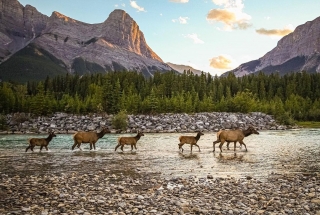How to Coexist with Wildlife in the Rockies
- Uncategorized
- January 13, 2023
- Share
Cougars and elk and bears, oh my! Wildlife is one of the biggest draws to the Canadian Rockies—but it can also be the most unnerving to encounter. Learning to coexist with the local wildlife is key, so we brought in Nick de Ruyter, WildSmart Program Director at the Biosphere Institute of the Bow Valley, to share tips and information on how to enjoy your time here, safely.
Living side-by-side with wildlife means respecting the natural cycles they follow throughout the year. “Different things are happening at different times of year,” says de Ruyter. “We need to be aware of seasonal considerations when planning our activities.”
Spring
Bears are waking up from hibernation in the spring, bringing them to the valley bottom to look for food. This time of year they go for green grass and dandelions found on roads, yards, and trails.
May and June are calving season for elk. For the first two weeks, elk calves lay still in the long grass. “Having the calves in town attracts predators,” says de Ruyter. “So those elk can be very protective.”
If you see a herd of elk:
If you can’t:
Summer
“During berry season there’s a high likelihood of encountering bears or having surprise encounters because they’re focused on eating for the winter, not on what’s going on around them,” says de Ruyter.
He suggests making lots of noise on the trails to make your presence known and not risk an encounter by surprising wildlife.
Fall
Fall is elk mating season. Anything that a male elk encounters that isn’t a female elk can be considered a threat, so avoiding them is important for safety. “They’re so focused on mating they can act aggressively,” de Ruyter explains. “Don’t get between them. Just like in spring: be careful, turn around.”
If bears had a bad berry season, they’re going to be stressed. “They’re hungry and heading into town, attracted to things in people’s backyards, fruit trees, bird feeders, recycling…right now they may act more boldly to get food they normally wouldn’t try to get,” de Ruyter explains.
“It’s up to us to ensure they don’t get a food reward,” he says. “It’s extremely important to manage your attractants properly, whether you’re a resident or a business because we just don’t want the wildlife to get into trouble.”
When wildlife becomes more comfortable with humans it can increase the number of human and wildlife encounters which can result in relocation and, in some cases, euthanization.
Winter
Bears are heading to their dens to hibernate, but that doesn’t mean you can leave the bear spray at home. “A big tip is to carry bear spray year round, even on popular trails,” de Ruyter stresses. “On any given day you could run into an elk, cougar, wolf, coyote, or bear.”
“The way to simplify encounters is to stop, talk, and walk,” says de Ruyter.
“Most of these are quite simple, straightforward things for residents and visitors to know when they’re using the trails to help reduce the risk of encounters,” says de Ruyter. “Generally when wildlife and people get close together, it’s the wildlife that pays the price.”
Get all the resources at biosphereinstitute.org/wildsmart
Discover what makes Canmore and Kananaskis special, from the people who know it best. Think differently, travel more sustainably, and gain a deeper understanding of the mountains with Peaks Academy. Learn more.
